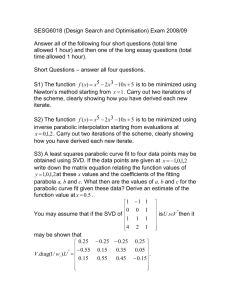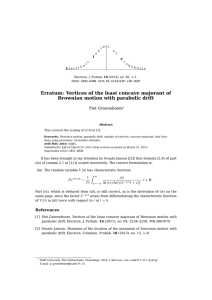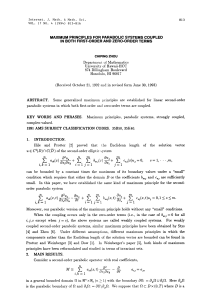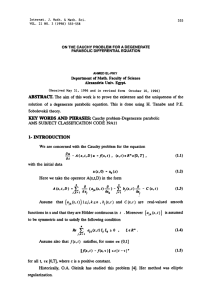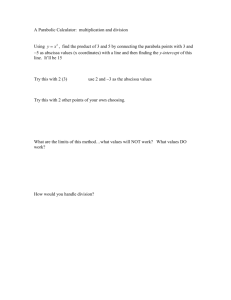Electronic Journal of Differential Equations, Vol. 2015 (2015), No. 38,... ISSN: 1072-6691. URL: or
advertisement
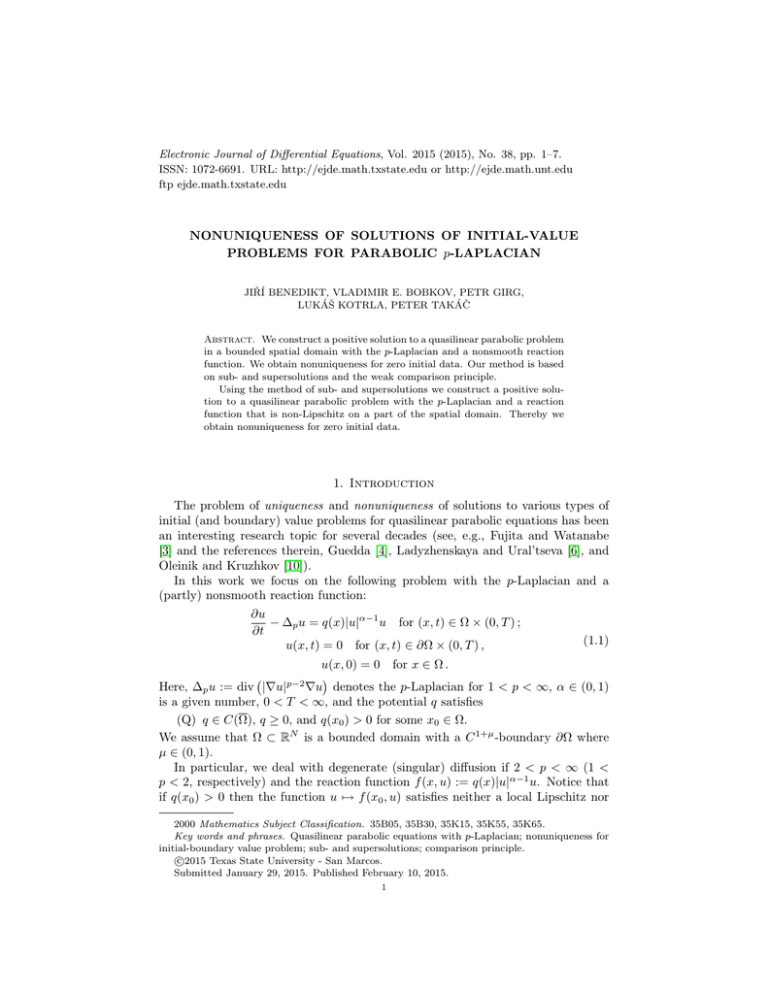
Electronic Journal of Differential Equations, Vol. 2015 (2015), No. 38, pp. 1–7.
ISSN: 1072-6691. URL: http://ejde.math.txstate.edu or http://ejde.math.unt.edu
ftp ejde.math.txstate.edu
NONUNIQUENESS OF SOLUTIONS OF INITIAL-VALUE
PROBLEMS FOR PARABOLIC p-LAPLACIAN
JIŘÍ BENEDIKT, VLADIMIR E. BOBKOV, PETR GIRG,
LUKÁŠ KOTRLA, PETER TAKÁČ
Abstract. We construct a positive solution to a quasilinear parabolic problem
in a bounded spatial domain with the p-Laplacian and a nonsmooth reaction
function. We obtain nonuniqueness for zero initial data. Our method is based
on sub- and supersolutions and the weak comparison principle.
Using the method of sub- and supersolutions we construct a positive solution to a quasilinear parabolic problem with the p-Laplacian and a reaction
function that is non-Lipschitz on a part of the spatial domain. Thereby we
obtain nonuniqueness for zero initial data.
1. Introduction
The problem of uniqueness and nonuniqueness of solutions to various types of
initial (and boundary) value problems for quasilinear parabolic equations has been
an interesting research topic for several decades (see, e.g., Fujita and Watanabe
[3] and the references therein, Guedda [4], Ladyzhenskaya and Ural’tseva [6], and
Oleinik and Kruzhkov [10]).
In this work we focus on the following problem with the p-Laplacian and a
(partly) nonsmooth reaction function:
∂u
− ∆p u = q(x)|u|α−1 u for (x, t) ∈ Ω × (0, T ) ;
∂t
(1.1)
u(x, t) = 0 for (x, t) ∈ ∂Ω × (0, T ) ,
u(x, 0) = 0 for x ∈ Ω .
Here, ∆p u := div |∇u| ∇u denotes the p-Laplacian for 1 < p < ∞, α ∈ (0, 1)
is a given number, 0 < T < ∞, and the potential q satisfies
(Q) q ∈ C(Ω), q ≥ 0, and q(x0 ) > 0 for some x0 ∈ Ω.
We assume that Ω ⊂ RN is a bounded domain with a C 1+µ -boundary ∂Ω where
µ ∈ (0, 1).
In particular, we deal with degenerate (singular) diffusion if 2 < p < ∞ (1 <
p < 2, respectively) and the reaction function f (x, u) := q(x)|u|α−1 u. Notice that
if q(x0 ) > 0 then the function u 7→ f (x0 , u) satisfies neither a local Lipschitz nor
p−2
2000 Mathematics Subject Classification. 35B05, 35B30, 35K15, 35K55, 35K65.
Key words and phrases. Quasilinear parabolic equations with p-Laplacian; nonuniqueness for
initial-boundary value problem; sub- and supersolutions; comparison principle.
c
2015
Texas State University - San Marcos.
Submitted January 29, 2015. Published February 10, 2015.
1
2
J. BENEDIKT, V. E. BOBKOV, P. GIRG, L. KOTRLA, P. TAKÁČ
EJDE-2015/38
an Osgood (see [11]) condition near u = 0 provided α ∈ (0, 1). The case p = 2
(the Laplace operator) was treated in Fujita and Watanabe [3] by entirely different
methods based on the Green’s function for the heat equation. An important special
case, N = 1, 1 < p < ∞, and q(x) ≡ λ > 0 (a constant), was treated in Guedda
[4] also by different methods. The main purpose of the present article is to fill
in the gap left open for 1 < p < ∞, p 6= 2, and q ∈ C(Ω), q ≥ 0, where q is not
necessarily positive everywhere in Ω. Because of this possibly nonuniform positivity
of q over Ω, the method used in [4] cannot be applied here. We use a different
approach based on sub- and supersolutions and the weak comparison principle.
As a trivial consequence of the fact that problem (1.1) possesses a nontrivial nonnegative solution (see our main result, Theorem 1), we conlude that the weak
comparison principle does not hold for problem (1.1) considered with nontrivial
initial conditions, say, in W01,p (Ω).
Observe that our assumption (Q) implies that there exists R > 0 such that
q(x) ≥ q0 ≡ const > 0 for all x ∈ BR (x0 ) where
BR (x0 ) := {x ∈ RN : |x − x0 | < R} ⊂ Ω.
Let (λ1 , ϕ1,R ) denote the first eigenpair for the operator −∆p : W01,p (BR (x0 )) →
0
W −1,p (BR (x0 )); that is,
p−1
−∆p ϕ1,R = λ1,R ϕ1,R
ϕ1,R = 0
in BR (x0 ) ;
on ∂BR (x0 ) ,
(1.2)
and ϕ1,R ∈ W01,p (BR (x0 )) is normalized by ϕ1,R (x0 ) = 1. Note that this normalization yields 0 < ϕ1,R (x) ≤ 1 for all x ∈ BR (x0 ). Moreover, we denote by
(
ϕ1,R (x) for x ∈ BR (x0 ) ;
(1.3)
ϕ
e1,R (x) :=
0
for x ∈ Ω \ BR (x0 ) ,
the natural zero extension of ϕ1,R from BR (x0 ) to the whole of Ω. Our main
theorem is the following nonuniqueness result.
Theorem 1.1. Assume that 0 < α < min{1, p − 1} and (Q) are satisfied. Then
there exists T > 0 small enough, such that problem (1.1) possesses (besides the
trivial solution u ≡ 0) a nontrivial, nonnegative weak solution
u ∈ C [0, T ] → L2 (Ω) ∩ Lp (0, T ) → W 1,p (Ω)
which is bounded below by a subsolution u : Ω × (0, T ) → R+ of type
u(x, t) = θ(t)ϕ
e1,R (x)β ≥ 0
in Ω × (0, T ) ,
where θ : [0, T ] → R+ is a strictly increasing, continuously differentiable function
with θ(0) = 0, and β ∈ (1, ∞) is a suitable number.
In contrast with this nonuniqueness result, several uniqueness results have been
established in [2].
Remark 1.2. Assume that q ∈ L∞ (Ω) satisfies 0 ≤ q(x) ≤ λ1 a.e. in Ω, where λ1
stands for the principal eigenvalue of −∆p with zero Dirichlet boundary conditions
on Ω. Then the condition α < p − 1 is essential for obtaining our nonuniqueness
EJDE-2015/38
NONUNIQUENESS FOR PARABOLIC p-LAPLACIAN
3
result. Namely, if α = p − 1 then u ≡ 0 is the unique weak solution of (1.1). The
uniqueness follows directly from the following standard energy estimate:
Z
Z
Z
Z
1 d
|u(x, t)|2 dx +
|∇u|p dx =
q(x)|u|p dx ≤ λ1
|u|p dx .
2 dt Ω
Ω
Ω
Ω
By the variational characterization of λ1 (Poincaré’s inequality in Lindqvist [8]),
we get
Z
Z
Z
1 d
2
p
|u(x, t)| dx ≤ −
|∇u| dx + λ1
|u|p dx ≤ 0 ,
2 dt Ω
Ω
Ω
which implies u(x, t) ≡ 0 in Ω × (0, T ), thanks to u(x, 0) ≡ 0 in Ω.
A weaker result than our Theorem 1.1 has recently been published in Merchán,
Montoro, and Peral [9, Theorem 2.2, p. 248]. There, a very strong uniform positivity condition on the potential q is assumed, q0 = inf Ω q > 0. This means that it
suffices to treat the constant case q(x) ≡ q0 = const > 0 and then use the resulting
solution as a subsolution for the general case q(x) ≥ q0 = const > 0. In contrast,
our Theorem 1.1 above does not assume q0 > 0; we assume only q ≥ 0 and q 6≡ 0 in
Ω. Nevertheless, our proof of this result, especially our construction of a nonzero
subsolution, is simpler than in [9].
2. Proof of Theorem 1.1
eβ1,R is continuously difNote that ϕ
e1,R defined in (1.3) is continuous on Ω and ϕ
ferentiable for any constant β > 1. We need to establish a few additional properties
of ϕ1,R (x) ≡ ϕ1,R (|x − x0 |) = ϕ1,R (r), with r = |x − x0 | and the usual harmless
abuse of notation.
Lemma 2.1. If β ∈ (0, ∞) then
(p−1)(β−1)−1 − ∆p ϕβ1,R = β p−1 ϕ1,R
λ1,R ϕp1,R − (p − 1)(β − 1)|∇ϕ1,R |p
(2.1)
holds pointwise a.e. in BR (x0 ). In particular, for β ≥ 1 we have
−∆p (ϕβ1,R )
ϕβ1,R
≤ C ≡ const < ∞
pointwise a.e. in BR (x0 ) .
(2.2)
Proof. Any function u : BR (x0 ) → R that is radially symmetric around x0 can be
written as u(x) = u(r) where r = |x − x0 |. Using this notation we obtain, by formal
differentiation,
x − x0 ∆p u(|x − x0 |) = div |u0 (r)|p−2 u0 (r)
r
(2.3)
0 N − 1
0
p−2 0
= |u (r)| u (r) +
|u0 (r)|p−2 u0 (r) .
r
It is well-known that the first eigenfunction ϕ1,R is radially symmetric around x0 ,
positive, and C 2 in BR (x0 ) \ {x0 }, see e.g. [1]. Therefore, we get a.e. in BR (x0 ),
∆p ϕβ1,R (r)
0
(p−1)(β−1) 0
= β p−1 ϕ1,R
|ϕ1,R |p−2 ϕ01,R
+
N − 1 p−1 (p−1)(β−1) 0 p−2 0
β
ϕ1,R
|ϕ1,R | ϕ1,R
r
4
J. BENEDIKT, V. E. BOBKOV, P. GIRG, L. KOTRLA, P. TAKÁČ
EJDE-2015/38
n
(p−1)(β−1)−1 0
|ϕ1,R |p
= β p−1 (p − 1)(β − 1)ϕ1,R
0 N − 1
o
(p−1)(β−1)
(p−1)(β−1) 0
+ ϕ1,R
|ϕ01,R |p−2 ϕ01,R +
ϕ1,R
|ϕ1,R |p−2 ϕ01,R
r
n
o
p−1 (p−1)(β−1)−1
=β
ϕ1,R
(p − 1)(β − 1)|ϕ01,R |p − λ1,R ϕp1,R
o
n
|ϕ01,R |p
(p−1)β
− λ1,R .
= β p−1 ϕ1,R
(p − 1)(β − 1) p
ϕ1,R
Hence,
(p−1)β
−∆p ϕβ1,R ≤ β p−1 λ1,R ϕ1,R
for β ≥ 1. For p ≥ 2 this yields
−∆p ϕβ1,R
ϕβ1,R
(p−2)β
≤ β p−1 λ1,R ϕ1,R
≤ β p−1 λ1,R ,
thanks to our normalization 0 < ϕ1,R ≤ 1. On the other hand, for 1 < p < 2,
−∆p ϕβ1,R
(p−2)β 0
p
= β p−1 ϕ1,R
λ1,R − (p − 1)(β − 1)ϕ−p
(2.4)
1,R |ϕ1,R | .
β
ϕ1,R
Since ϕ1,R is radially decreasing and satisfies the Hopf maximum principle on the
boundary of BR (x0 ), we can choose ε > 0 such that ϕ01,R (r) < ϕ01,R (R)/2 < 0 for
all r ∈ (R − ε, R).
Hence, (2.4) implies (2.2) for R − ε ≤ r < R provided ε > 0 is small enough,
such that
0
p
λ1,R − (p − 1)(β − 1)ϕ−p
1,R |ϕ1,R | ≤ 0 for R − ε ≤ r < R .
At the same time, the ratio −∆p ϕβ1,R /ϕβ1,R is bounded for 0 < r ≤ R − ε. Thus,
estimate (2.2) holds a.e. in BR (x0 ).
Proposition 2.2. Assume that 0 < α < min{1, p − 1} and (Q) are satisfied. Given
any fixed number S ∈ (0, ∞), we define
u(x, t) := θ(t)ϕ
e1,R (x)β
for (x, t) ∈ Ω × [0, S] ,
where β > 1, ϕ
e1,R is given by (1.3), and θ : [0, S] → R+ is the positive solution of
the Cauchy problem
q0
dθ
(t) = θα (t) for t ∈ (0, S) ; θ(0) = 0 ,
(2.5)
dt
2
such that 0 < θ(t) < ∞ for every t ∈ (0, S). Then u : Ω × (0, S) → R+ is a
subsolution of problem (1.1) in a smaller domain Ω × (0, σ), i.e., for t ∈ (0, σ) only,
where σ ∈ (0, S) is small enough.
Proof. We will show that the following inequality holds
∂u
− ∆p u ≤ q(x)|u|α−1 u.
∂t
Using 0 < α < min{1, p − 1}, equation (2.5), and the continuity of θ : [0, S) → R+ ,
we get
dθ
≤ − Cθ(t)p−1 + q0 θ(t)α for all t ∈ [0, σ] ,
(2.6)
dt
EJDE-2015/38
NONUNIQUENESS FOR PARABOLIC p-LAPLACIAN
5
where σ ∈ (0, S) is small enough, such that θ(t)p−1−α ≤ q0 /(2C) holds for all
t ∈ [0, σ].
Inserting the inequality
β
ϕ−β
1,R ∆p (ϕ1,R ) ≥ −C ≡ const
in Ω from Lemma 2.1, inequality (2.2), into (2.6), we obtain
dθ
β
p−1
≤ ϕ−β
+ q0 θ(t)α
1,R ∆p (ϕ1,R )θ(t)
dt
(α−1)β
β
p−1
≤ ϕ−β
+ q0 ϕ1,R θ(t)α ,
1,R ∆p (ϕ1,R )θ(t)
thanks to the normalization 0 < ϕ1,R ≤ 1 in BR (x0 ) combined with (α − 1)β < 0.
Finally, multiplying by ϕβ1,R , we arrive at
dθ β
ϕ
≤ ∆p (ϕβ1,R )θ(t)p−1 + q0 θ(t)α ϕα
1,R
dt 1,R
β
p−1
α α
≤ ∆p (ϕ1,R )θ(t)
+ q(x)θ(t) ϕ1,R .
This inequality, combined with our definition of the function ϕ
e1,R , guarantees that
e1,R (x) is a subsolution to problem (1.1).
u(x, t) = θ(t)ϕ
1
1−α
Proof of Theorem 1.1. First, let us observe that u(x, t) = kqk∞
t is a supersolution
of (1.1) for 0 < t ≤ 1. Indeed, a straightforward calculation shows that
α
1
1
∂u
1−α
1−α
− ∆p u = kqk∞
≥ q(x) kqk∞
t = q(x)|u|α−1 u
∂t
holds for 0 < t ≤ 1, since q ∈ C(Ω), q ≥ 0, and kqk∞ = supx∈Ω q(x).
Second, we show now that u ≤ u for all x ∈ Ω and all t > 0 sufficiently small,
say, 0 < t ≤ σ. Evidently,
1
1
1
1−α
u(x, t) = θ(t)ϕ
e1 (x)β = c1 t 1−α ϕ
e1 (x)β ≤ c1 t 1−α ≤ u(x, t) = kqk∞
t
for 0 < t ≤ σ, where σ satisfies
σ α ≤ kqk∞ /c1−α
.
1
Now it remains to show the existence of weak solution u for (1.1), such that
u≤u≤u
in Ω × (0, T ) ,
where T := min{σ, σ} > 0.
Let us define a sequence of functions un : Ω × (0, T ) → R recursively for n =
1, 2, 3, . . . , such that un is the unique weak solution of
∂un
− ∆p un = q(x)|un−1 |α−1 un−1 , (x, t) ∈ Ω × (0, T ),
∂t
un (x, 0) = 0, x ∈ Ω,
un (x, t) = 0,
(2.7)
(x, t) ∈ ∂Ω × (0, T ),
with u0 = u. By a weak solution of (2.7), we mean a Lebesgue-measurable function
un : Ω × (0, T ) → R that satisfies
un ∈ C([0, T ] → L2 (Ω)) ∩ Lp (0, T ) → W01,p (Ω)
6
J. BENEDIKT, V. E. BOBKOV, P. GIRG, L. KOTRLA, P. TAKÁČ
and the equation
Z
EJDE-2015/38
Z tZ
∂φ
un (x, t)φ(x, t) dx −
un (x, s) (x, s) dx ds
∂t
Ω
0
Ω
Z tZ
|∇un (x, s)|p−2 h∇un (x, s), ∇φ(x, s)i dx ds
+
0
Ω
Z tZ
q(x)|un−1 (x, s)|α−1 un−1 (x, s)φ(x, s) dx ds
=
0
(2.8)
Ω
for every t ∈ (0, T ) and every test function
0
0
φ ∈ C [0, T ] → L2 (Ω) ∩ Lp (0, T ) → W01,p (Ω) ∩ W 1,p (0, T ) → W −1,p (Ω) .
The questions of existence and uniqueness of weak solutions of problems of type
(2.7) obtained by monotone iterations have been discussed in [12, Appendix A,
§A.1]. Let us deduce from the fact that u0 = u is a subsolution of (1.1) the
inequalities un−1 ≤ un in Ω × (0, T ) for every n = 1, 2, 3, . . . . The proof is by
induction on n. The first inequality, u0 ≤ u1 in Ω × (0, T ), holds by the Weak
Comparison Principle (see [12, Lemma 4.9, p. 618]) and the fact that u0 = u is a
subsolution of (1.1). Now assume that un−1 ≤ un in Ω × (0, T ) for some n ∈ N.
Then we have
∂un
∂un+1
− ∆p un = |un−1 |α−1 un−1 ≤ |un |α−1 un =
− ∆p un+1
∂t
∂t
in Ω × (0, T ) and consequently un ≤ un+1 in Ω × (0, T ) again, by [12, Lemma
4.9, p. 618]. Therefore, monotonicity holds: u = u0 ≤ u1 ≤ u2 ≤ · · · ≤ u in
Ω × (0, T ). The comparison with the supersolution u is deduced again from the
Weak Comparison Principle. Hence, un is uniformly bounded in Ω × (0, T ) by
u ≤ u ≤ u. A global regularity result from [7, Theorem 0.1, p. 552] (cf. [12,
1+γ
Lemma 4.6, p. 617]) guarantees un ∈ C 1+γ, 2 (Ω × [0, T ]) uniformly for n ∈ N,
where γ ∈ (0, 1) is independent of n. We follow the notations and definitions of
Hölder spaces of functions on Ω × [0, T ] from [5, Chpt. 1, p. 7]. Thus, by the
Arzelà-Ascoli theorem, {un } is relatively compact in C 1,0 (Ω × [0, T ]). Hence, the
sequence {un } possesses a subsequence which converges to u ∈ C 1,0 (Ω × [0, T ]).
Therefore, in the weak formulation of (2.8) we may pass to the limit as n → ∞,
thus verifying that the limit function u is a weak solution of (1.1) in Ω × (0, T ),
such that u ≤ u ≤ u.
Acknowledgments. All authors were partially supported by a joint exchange program between the Czech Republic and Germany: By the Ministry of Education,
Youth, and Sports of the Czech Republic under the grant No. 7AMB14DE005
(exchange program “MOBILITY”) and by the Federal Ministry of Education and
Research of Germany under grant No. 57063847 (D.A.A.D. Program “PPP”).
The research of Peter Takáč was partially supported also by the German Research Society (D.F.G.), grant No. TA 213 / 15-1 and the research of Vladimir E.
Bobkov was supported by the German Research Society (D.F.G.), grant No. TA
213 / 16-1 (doctoral fellow).
References
[1] Bhattacharya, T.; Radial symmetry of the first eigenfunction for the p-Laplacian in the ball,
Proc. Amer. Math. Soc. 104 (1988), no. 1, 169–174.
EJDE-2015/38
NONUNIQUENESS FOR PARABOLIC p-LAPLACIAN
7
[2] Bobkov, V. E.; Takáč, P.; A Strong Maximum Principle for parabolic equations with the
p-Laplacian, J. Math. Anal. Appl. 419 (2014), no. 1, 218–230.
[3] Fujita, H.; Watanabe, S.; On the uniqueness and non-uniqueness of solutions of initial value
problems for some quasi-linear parabolic equations, Comm. Pure Appl. Math. 21 (1968),
631–652.
[4] Guedda, M.; The one-dimensional parabolic equations associated to the p-Laplacian operator,
Analele Ştiinţifice Univ. Iaşi, 45(1) (1999), 1–14.
[5] Ladyzhenskaya, O. A., Solonnikov, V. A., Ural’tseva, N. N.; Linear and quasi-linear equations
of parabolic type, Izdat. “Nauka”, Moscow (1967), 736 pp.; Translated from the Russian by S.
Smith. Translations of Mathematical Monographs, Vol. 23 American Mathematical Society,
Providence, R.I. 1968 xi+648 pp.
[6] Ladyzhenskaya, O. A., Ural’tseva, N. N.; A boundary-value problem for linear and quasilinear parabolic equations. I, Izv. Akad. Nauk SSSR Ser. Mat. 26 (1962), 5–52.
[7] Lieberman, G. M.; Boundary and initial regularity for solutions of degenerate parabolic equations, Nonlinear Anal. 20 (1993), no. 5, 551–569.
[8] Lindqvist, P.; On the equation div(|∇u|p−2 ∇u) + λ|u|p−2 u = 0, Proc. Amer. Math. Soc. 109
(1990), no. 1, 157–164.
[9] Merchán, S.; Montoro, L.; Peral, I.; Optimal reaction exponent for some qualitative properties
of solutions to the p-heat equation, Commun. Pure Appl. Anal. 14 (2015), no. 1, 245–268.
[10] Oleinik, O. A., Kruzhkov, S. N.; Quasi-linear parabolic second-order equations with several
independent variables, Uspehi Mat. Nauk 16 (1961), 115–155.
dy
[11] Osgood, W. F.; Beweis der Existenz einer Lösung der Differentialgleichung dx
= f (x, y)
ohne Hinzunahme der Cauchy-Lipschitz’schen Bedingung, (German) Monatsh. Math. Phys. 9
(1898),no. 1, 331–345.
[12] Padial, J. F., Takáč, P., Tello, L.; An antimaximum principle for a degenerate parabolic
problem, Adv. Differential Equations 15 (2010), no. 7–8, 601–648.
Jiřı́ Benedikt
Department of Mathematics and NTIS, Faculty of Applied Scences, University of West
Bohemia, Univerzitnı́ 22, CZ-306 14 Plzeň, Czech Republic
E-mail address: benedikt@kma.zcu.cz
Vladimir E. Bobkov
Fachbereich Mathematik, Universität Rostock, Germany
E-mail address: vladimir.bobkov@uni-rostock.de
Petr Girg
Department of Mathematics and NTIS, Faculty of Applied Scences, University of West
Bohemia, Univerzitnı́ 22, CZ-306 14 Plzeň, Czech Republic
E-mail address: pgirg@kma.zcu.cz
Lukáš Kotrla
Department of Mathematics and NTIS, Faculty of Applied Scences, University of West
Bohemia, Univerzitnı́ 22, CZ-306 14 Plzeň, Czech Republic
E-mail address: kotrla@ntis.zcu.cz
Peter Takáč
Fachbereich Mathematik, Universität Rostock, Germany
E-mail address: peter.takac@uni-rostock.de

